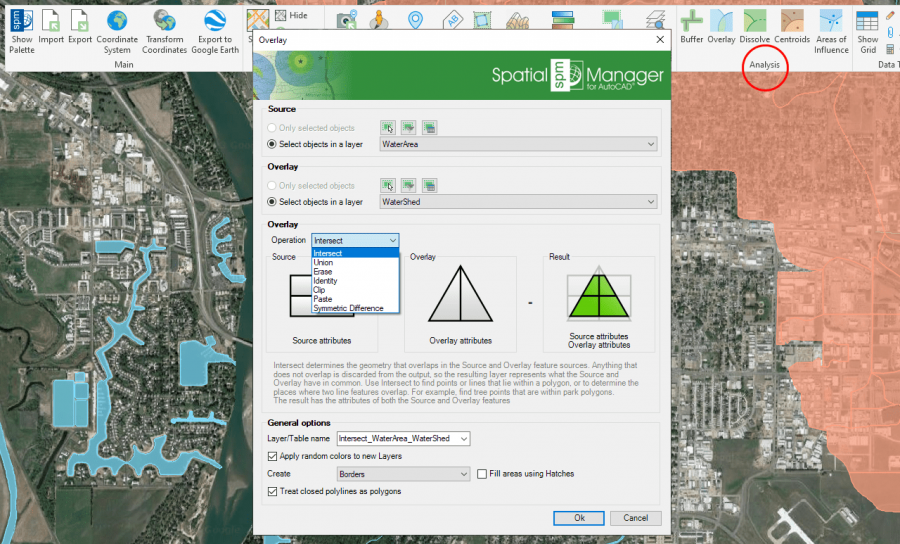Spatial Manager™ for AutoCAD - FAQs: GIS Analysis ("Professional" edition only)
Notes:
- Some components in the images on this page (providers, names, windows look, etc.) may be slightly different from those that will appear on your computer
- Some application functions need to access the Internet from the application itself. If you experiment problems in any process, ask your network administrator if there is a Proxy server installed on your network. You can configure the Proxy settings through the application options
Introduction
- Objective of this section
- To learn how to use advanced GIS analysis tools in your drawings and maps
- Topics in this section
- Create Buffers from point, linear or polygonal borders objects
- Process spatial Overlays which will create new drawing objects based on the operation results
- Dissolve polyonal objects in order to create surrounds of adjacent objects
- Create Centroids from selected polygons
- Calculate and draw Areas of Influence from selected point objects
GIS Analysis tools
Spatial Manager™ for AutoCAD includes a set of advanced tools designed for geometric and spatial analysis of geographic objects and their geometric relationships, resulting in new objects generated from the resolution of such analysis
Note: The GIS Analysis tools were introduced in the version 7 of the application, so are not available for some old Autodesk products

Performing GIS Analysis in the drawing
About objects selection
Some of the analysis tools described below allow object selections before or during their execution. Even some of them (SPMOVERLAY) allow you to select two groups of objects to operate between them. For all of these commands, the following notes and instructions apply:
- Select all objects: All objects in the drawing will be processed
- Only selected objects: Only a selection of objects will be processed. You can select the objects before executing the commands or by using the Selecting buttons in their corredponding windows
- Manual selection
- Select by Query: Select objects according to the result of a simplex or compound data query (See "Selecting by Query")
- Select by Table: Select objects which have been previously attached to a specific data table (See "Selecting by Table")
- Note: As you can select the objects previously to execute the commands, in addition to the use of the above included selection options or in combination with them, you can make use of some other Advanced selection application tools, select objects in the Data Grid or any other selection method available in AutoCAD (Quick Select, etc.). Also note that, as most of the advanced application or AutoCAD selection commands will let you apply the selection to the current selection, the number of possible combinations to select what you are interested in is almost unlimited
- Select objects in a layer: Only the objects included in an AutoCAD Layer will be processed. You can select the layer using the drop-down list in this window
Note: The selection of objects in AutoCAD may be a few slower when the "SpatialManager" palette is open, depending on the data of the objects
Buffer
The command 'SPMBUFFER' in Spatial Manager™ for AutoCAD allows you to generate Buffered polygons around point objects, linear objects or polygon boundaries. Buffer distance can be constant or taken from the value of a table field for each object, it is possible to merge the generated objects in their common areas and different styles of joins and endings can be chosen
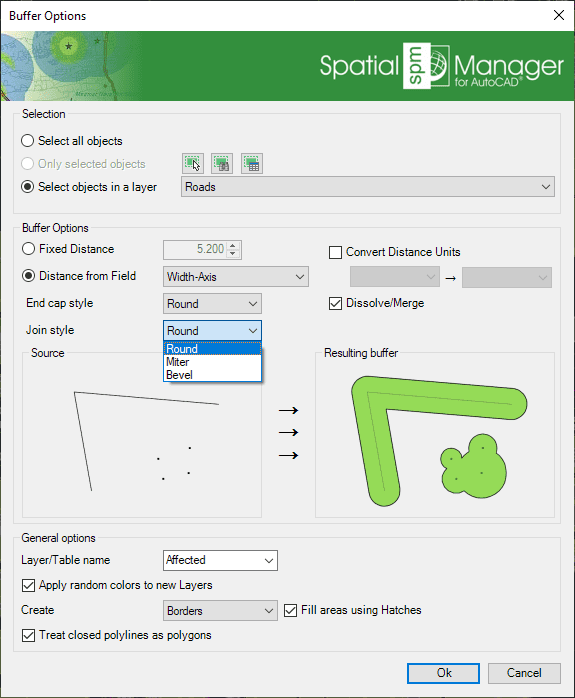
- Objects selection: See the paragraph "About objects selection" above
- Buffer options: You can select the Buffer distance (fixed value or field-based value), the Join and End cap styles, the Buffer Units conversion (so you can define the Buffer distance in units other than the drawing units) and if you want to Dissolve/Merge the generated Buffered polygons
- Table/Layer name: This setting defines the target Layer and data table name for the Buffers. You can select an existing Layer in the drawing or you can write the name to create a new Layer. Buffer objects will adopt the same data as the objects that generate them, unless the "Dissolve/Merge" option has been checked, in which case this would not make sense and the combined Buffer objects are not attached to any data table
- Apply random colors to new Layers
- Create: Buffer objects type, Borders or Polygons. The Polygons option allow you to select MPolygons as the type of object to use. This options is available on all compatible Autodesk products (even on vanilla, plain or basic AutoCAD) (AutoCAD 2013 and upper). The MPolygons can be defined by multiple rings, even including holes, as a single AutoCAD object
- Fill areas using Hatches
- Treat closed polylines as polygons: When checked (default value), all closed Polylines in the drawing will be considered as Polygons and not as linear objects. Most of the time the closed polylines represent polygonal elements
Overlay
(under development)
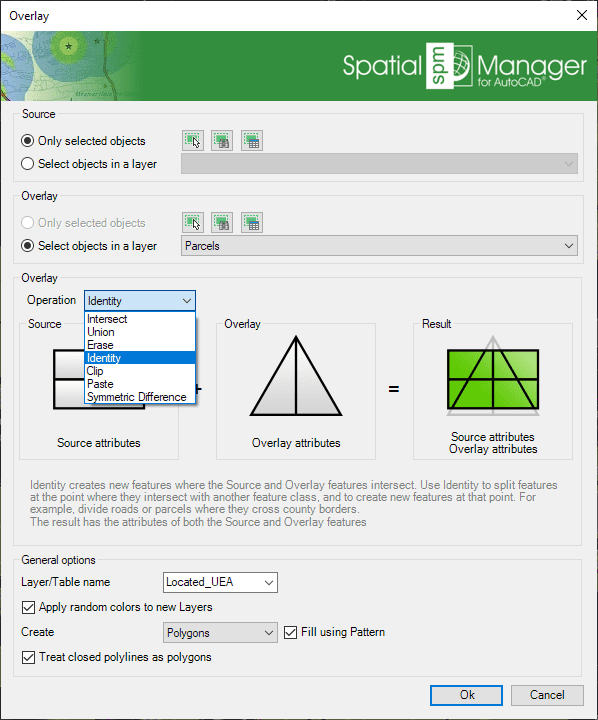
Dissolve
(under development)
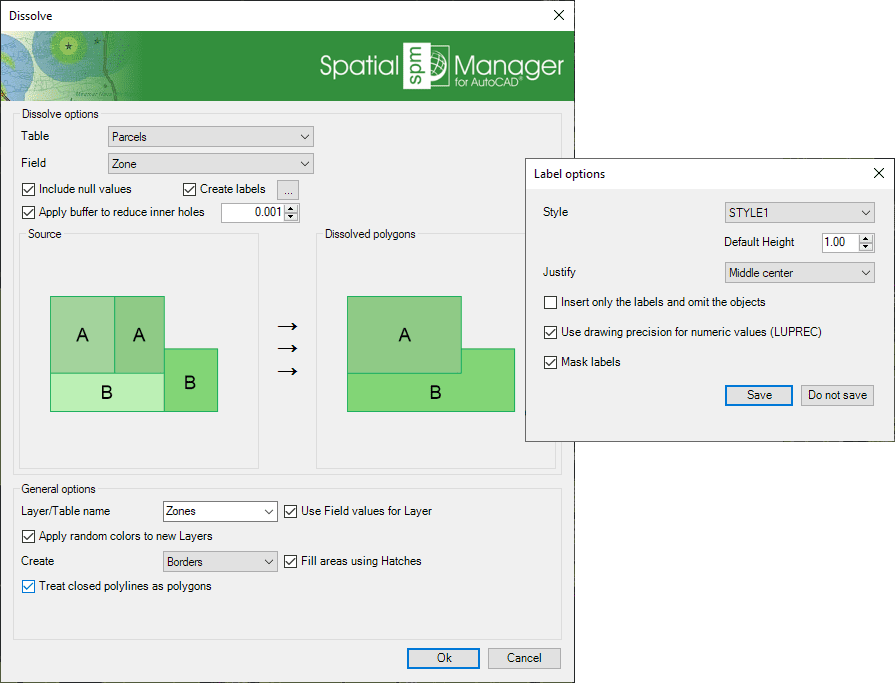
Centroids
(under development)
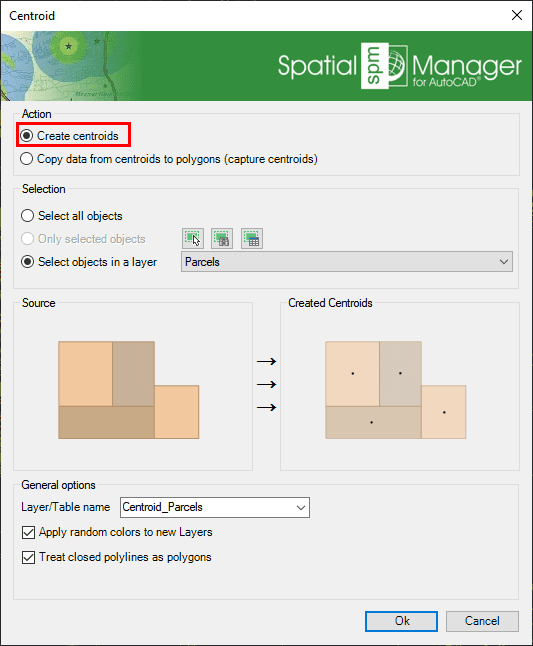
Areas of Influence
(under development)
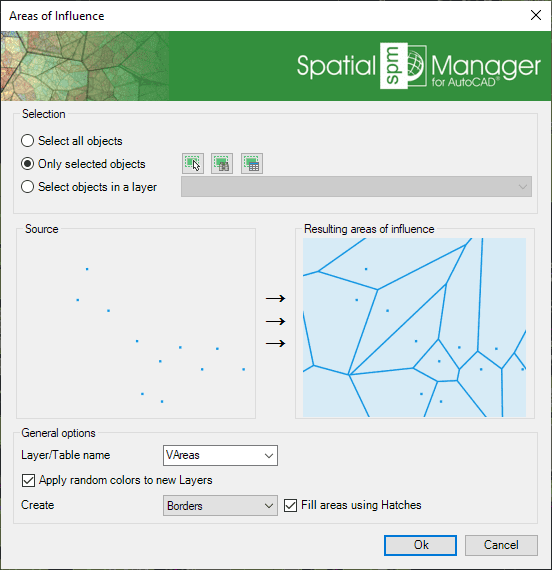
Related links
